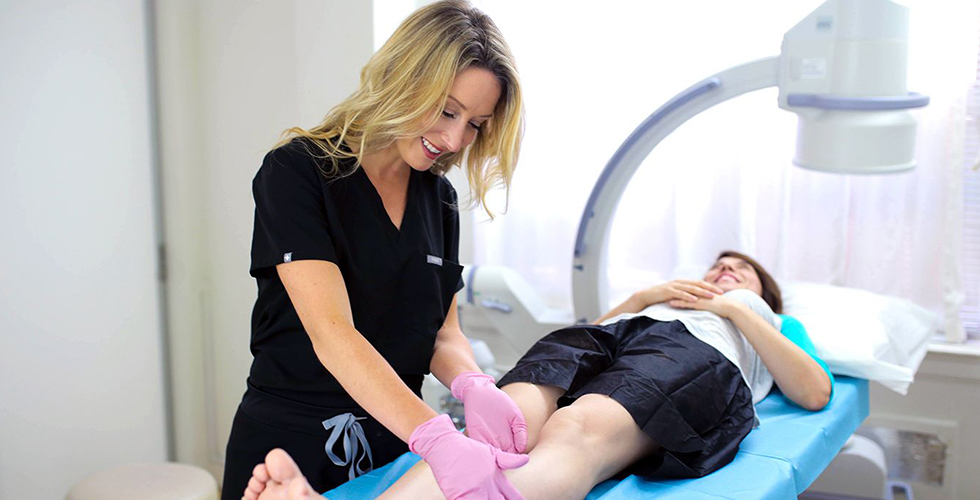Introducing Our Vein Doctor in Texas
The Spider Vein and Varicose Vein Clinic is led by Dr. Calvin Jung, an incredibly talented and charismatic vein doctor in Texas. He specializes in vascular imaging and the latest minimally invasive spider vein and varicose vein treatments. Dr. Jung graduated at the top of his class from the NYU School of Medicine, following which he specialized in cosmetic surgery and venous disease. He currently performs minimally invasive vein treatments to liberate patients from spider veins, varicose veins, and other vein problems.
Dr. Jung believes chronic venous insufficiency is a rampant problem and perhaps one of the country’s most under-diagnosed diseases. Most people can’t identify the early warning signs of vein disease, such as leg heaviness, restless leg syndrome, frequent leg cramps, and leg pain, because they resemble the signs of aging or exhaustion. Furthermore, others assume that spider veins are cosmetic problems or that varicose vein treatment necessitates complex surgeries and downtime. None of that is true, but the myths often prevent patients from seeking timely vein care.
This article aims to set the records straight. We provide a comprehensive guide to spider vein and varicose vein treatments, so you know exactly what to expect. You can find our spider vein and varicose vein clinic at 2900 Weslayan St Suite 650, Houston, a short drive from The Galleria shopping mall. Please book an appointment for the diagnosis and treatment of your vein problems today.

Step 1: Initial Consultation
Your spider vein and varicose vein treatment starts with an initial consultation. At this stage, we aim to understand your specific goals and concerns and determine if you might have chronic venous insufficiency, the root cause of most vein problems. Venous insufficiency is a medical condition wherein the collapse of your vein valves makes blood flow backward and accumulate in the leg veins, eventually leading to spider veins and varicose veins. Treating spider veins and varicose veins without addressing the root cause is a wasted endeavor — the vein problems will simply return.
During your initial consultation, you can expect the following from your vein doctor:
- Physical Examination: The vein doctor will examine your leg veins to identify the visible signs of venous insufficiency, such as spider veins, varicose veins, leg swelling, and skin discoloration. This will signal the extent of your vein disease.
- Discussion of Symptoms: The vein doctor will ask you to describe the symptoms of vein disease, such as leg heaviness, frequent leg cramps, restless leg syndrome, leg pain, and leg swelling. These symptoms indicate early chronic venous insufficiency, especially if they worsen at the end of the day or after long periods of sitting or standing still.
- Medical History: The vein doctor will examine your medical history and ask if you have a family history of vein problems. A personal history of deep vein thrombosis and a family history of vein problems are strong risk factors for chronic venous insufficiency.
- Vascular Imaging: The vein doctor will finally administer ultrasound diagnostic scans, such as duplex ultrasound, to visualize the blood flow in your leg veins. Studying the direction of blood flow allows the vein doctor to diagnose chronic venous insufficiency with certainty.
Step 2: Treatment Planning
Your vein doctor will curate a personalized vein treatment plan after diagnosing the root cause of your vein problems. Your vein treatment plan will be designed based on numerous factors, such as the location and size of your varicose veins, the number of spider veins on your legs, whether you have chronic venous insufficiency, your cosmetic goals, medical history, and your insurance coverage options. The vein doctor will also discuss all of your vein treatment options, highlighting the advantages, drawbacks, risks, and costs of each procedure to help you make an informed decision.
Step 3: Primary Vein Treatment
The primary vein treatment is meant for patients with chronic venous insufficiency. At this stage, the vein doctor will use numerous techniques to collapse or neutralize the diseased saphenous vein responsible for your vein problems. Removing the diseased vein allows the accumulated blood to flow into healthier leg veins, thereby restoring optimal blood circulation to the heart.
The following are your minimally invasive vein treatment options:
- Radiofrequency Ablation: The vein doctor makes a small incision on the skin’s surface and inserts a catheter into the diseased vein. The catheter generates thermal energy to collapse the diseased saphenous vein.
- Endovenous Laser Ablation: The vein doctor makes a small incision on the skin’s surface and inserts a laser fiber into the problematic vein. The laser fiber generates laser energy to destroy the diseased vein.
- VenaSeal: The vein doctor injects an FDA-approved vein glue into the diseased vein under ultrasound guidance. The diseased vein’s walls seal shut, and it becomes a hardened tissue eventually metabolized by the body.
Step 4: Cosmetic Vein Treatment
The cosmetic vein treatment is meant for patients with superficial varicose veins and spider veins without underlying vein disease. The vein doctor uses numerous techniques to remove the diseased veins, thus improving your leg’s appearance. However, this treatment doesn’t address the root cause of vein disease, so it should only be performed after the primary vein treatment.
The following are your spider vein and varicose vein treatment options:
- Ambulatory Phlebectomy: The vein doctor makes small incisions on the skin’s surface to extract superficial varicose veins.
- Sclerotherapy: The vein doctor injects a sclerosant solution into the spider veins, turning them into hardened scar tissues eventually absorbed by the body.
Step 5: Aftercare Guidelines
Minimally invasive spider vein and varicose vein treatments usually conclude after an hour with no downtime. The friendly staff at our vein clinic will discuss all of your aftercare guidelines, following which you can resume most of your daily activities and work. You may have to wear compression stockings for a few weeks, and you’ll be asked to walk frequently, to facilitate optimal blood circulation and recovery.
Recent Comments